Forward to the past. TBDR - the Power We Are
Yeah, these guys!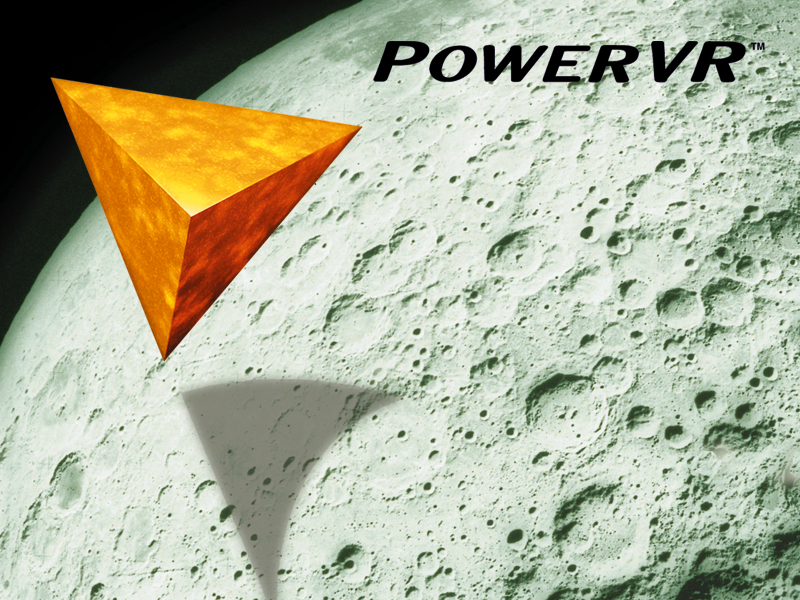

Imagination Technologies is one of the few who have proven that in this world you can definitely exist in two entities at once: in the shade and in profit. If anyone knows how to optimize the rendering of a 3D scene, Kristof Beets always knows more. In the “past years”, the man was the face of PowerVR (a division of Imagination Technologies engaged in the development of 3D-graphics chips) and told us about how he, together with a couple of people, came up with a new way of rendering. In the brochures that dotted every review of video cards based on their chips, you could always find a very crude explanation of the traditional rendering method and its brilliant evolution - tile rendering, which thundered so much in 2001 that ... you haven’t heard? But it was loud !
3D Pipeline as it was
Today on the operating table we have ... who would you think?
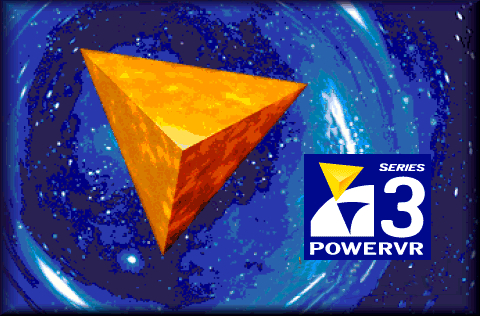
PowerVR Series 3 ! Oh yes, we’ll open it properly, but first, a little history. At the time of entering the market, he had to compete with giants such as the ATI R100 and NVIDIA Giraffe 3 . These were serious decisions, but PowerVR were not going to race for megahertz. According to PowerVR, the two of them draw 3D-graphics with the established
3D pipeline?
Right! But wait, you still need to get on it ...
But for a start we need to build a 3D scene in some application. Remember the drawing lessons: how do you draw, for example a cube? So in 3D-modeling ( 3-Dimensional Modeling) you also draw in the projection on the plane (which you define yourself), each point of which can be described as: xyzwhere . But initially, before you is immense space (space), and you need to ask at least one this plane here. And here such a simple figure as a triangle comes to the rescue - he will cope with it perfectly. The further scenario is the most diverse, for example, on this plane we can place something or we can attach another plane to our plane ...
So, classic figures (primitives ) for constructing any other geometric shapes ( polygons ) in the concept of 3D modeling are triangles. Why:
By the way, in fact, the application does not give the video card a ready-made 3D model of the scene, but only the coordinates of the vertices of the polygons in our space.
And now, finally, the scene data (vertex coordinates) was received by the video card and then they get to the graphics pipeline (3D pipeline). 3D Pipeline is a standardized algorithm for the operation of a 3D accelerator (video card, if you want).
At the first stage, the video card will have to convert the coordinates of the vertices several times to other coordinates in order to get a 3D model of the scene and only after that start lighting, shading, texturing, and other 3D pipeline steps, which can be read about here .
As a result, in the buffer of the final frame (framebuffer ) one full frame is formed and output. Ideally, these frames should be kept at least 25 per second (this was called FPS - Frames per Second), otherwise the human eye will notice that the image on the screen is intermittently displayed.
I would like to unscrew another myth along the way: If you forget about VSync, then the speed of the game does not depend on fps . The speed of the game depends on whether the HDD, CPU and RAM are in time. But the smoothness of the image - yes, that's what Vidyaha with its FPS is responsible for. Think of the same Unreal on early 3D graphics cards, for example, when you realized that you were killed before you even saw it.
Until recently, the de facto standard was FPS = 60, which gives a very a smooth picture, compared with FPS = 25. Today, with a monitor with a refresh rate of more than 60Hz, you can try to watch modern games that also have support for outputting FPS> 60. They say nothing like that;)
But for a start we need to build a 3D scene in some application. Remember the drawing lessons: how do you draw, for example a cube? So in 3D-modeling ( 3-Dimensional Modeling) you also draw in the projection on the plane (which you define yourself), each point of which can be described as: xyz
So, classic figures (primitives ) for constructing any other geometric shapes ( polygons ) in the concept of 3D modeling are triangles. Why:
- The triangle is flat. You can be sure that all three of its vertices are in the same plane.
- All other polygons can be built from them. And even very quickly using the triangle strips method .
Now right away there are smart people who will ask: “But how to make circles out of triangles?” Yes, there will be problems with this ... Well, but what of the lines? ;) Yes, exactly the same .
By the way, in fact, the application does not give the video card a ready-made 3D model of the scene, but only the coordinates of the vertices of the polygons in our space.
And now, finally, the scene data (vertex coordinates) was received by the video card and then they get to the graphics pipeline (3D pipeline). 3D Pipeline is a standardized algorithm for the operation of a 3D accelerator (video card, if you want).
At the first stage, the video card will have to convert the coordinates of the vertices several times to other coordinates in order to get a 3D model of the scene and only after that start lighting, shading, texturing, and other 3D pipeline steps, which can be read about here .
As a result, in the buffer of the final frame (framebuffer ) one full frame is formed and output. Ideally, these frames should be kept at least 25 per second (this was called FPS - Frames per Second), otherwise the human eye will notice that the image on the screen is intermittently displayed.
I would like to unscrew another myth along the way: If you forget about VSync, then the speed of the game does not depend on fps . The speed of the game depends on whether the HDD, CPU and RAM are in time. But the smoothness of the image - yes, that's what Vidyaha with its FPS is responsible for. Think of the same Unreal on early 3D graphics cards, for example, when you realized that you were killed before you even saw it.
Until recently, the de facto standard was FPS = 60, which gives a very a smooth picture, compared with FPS = 25. Today, with a monitor with a refresh rate of more than 60Hz, you can try to watch modern games that also have support for outputting FPS> 60. They say nothing like that;)
Classic 3D pipeline through the eyes of PowerVR
Well, back to
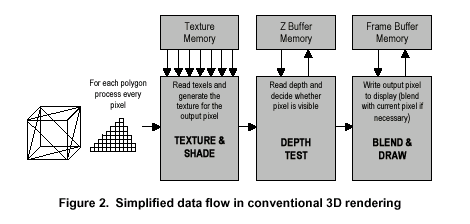
If you believe the scheme, then the classic 3D pipeline is exactly the following :
The application generates a frame with polygons in RAM and gives it to the video card for eating. Each polygon in gpu is first rasterized and textured, and only then there is a check for overlapping it with another polygon in the scene. That is, in essence, it turns out that we can first prepare a complex tree in our memory, then prepare the same complex person, and only then realize that a person will almost completely cover this whole tree. Yes, IMR is somehow ineffective. It turns out overdraw .
What PowerVR offers
And PowerVR has been offering us this year: " Think before you start to render! ".
It would seem so simple! We just need to swap the first two stages in the picture.
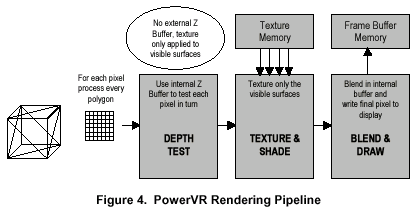
But behind all this lies one big problem: at that time, the entire 3D pipeline was hardwired into the chips in hardware (from geometry to output to the framebuffer). Therefore, PowerVR abruptly changed the 3D pipeline in their chips, at the same time inventing their own rendering method: Tile Based Deferred Rendering !!! The Deferred keyword , because there were, for example, Intel GMA video cards that used Coined Zone Rendering , which is essentially also Tile-Based.
Intel uses a similar concept in their integrated graphics solutions. However, their method, coined zone rendering , does not perform full hidden surface removal (HSR) and deferred texturing, therefore wasting fillrate and texture bandwidth on pixels that are not visible in the final image.
...
en.wikipedia.org/wiki/PowerVR
And in fact...
... of course, it was not quite like that. Namely:
- At first (1995 - 2000), things with IMR cards did well and TBDR cards did not have much advantage, remaining in the shade. But even in 2001, PowerVR cards didn’t really go out much. Because the vendors of IMR chips conducted independent investigations in a timely manner and, as a result, without intrigue and scandals, the vendors quickly realized that the typical 3D world was becoming more complex and multi-layered. It became clear to everyone that now the botnek is video memory with its bandwidth, and that it is necessary to optimize the work with this memory and it is mandatory with z-buffer.
So almost simultaneously in 2001 saw the release of such different technologies as ATI's HyperZ and Lightspeed Memory Architectureat NVIDIA. And, if the first one at the dawn of its appearance sifted out overdraw just immediately before the rasterization, then the second one did it at the level of geometry! - In addition, of course, PowerVR was a bit cunning. The diagram of the classic 3D IMP pipeline that they bring (see Classic 3D pipeline in the eyes of PowerVR ) clearly lacked shaders that were already in their infancy even on giraffe 2 (this was called NSR ). Well, every self-respecting chip in 2001 (ATI R100 , NVIDIA Giraffe 3 ) already had full-fledged pixel or even vertex shaders, which opened the "polygons of possibilities" for managing 3D pipline.
However, note that TBDR was still coined long before the shaders!
For the above reasons, PowerVR again fell into the shadows and their further fate was in another segment (hello to the owners of the iPhone). But what was the PowerVR Series 3 chip really capable of, the cards on which never reached us?
Out of the corner of my eye
When it comes to rarities like PowerVR cards, you have to be content with snatching. That is, there will not be such untwisted guys like Videologic Vivid! or Hercules 3D Prophet , but there will be, for example, such a thing: In the photo there is an AGP video card SUMA Platinum K2 on the very last released PowerVR chip in the PC segment - PowerVR Series 3 . All such cards were made according to the same reference design, but on this Korean there is no PowerVR inscription, from which the ignorant could pass by. The cooler here is from Asus, because on all these boards there were very noisy low-profile coolers, which soon ordered them to live long. In addition, now all the details on the card are in place :) On the map, I updated the latest BIOS .
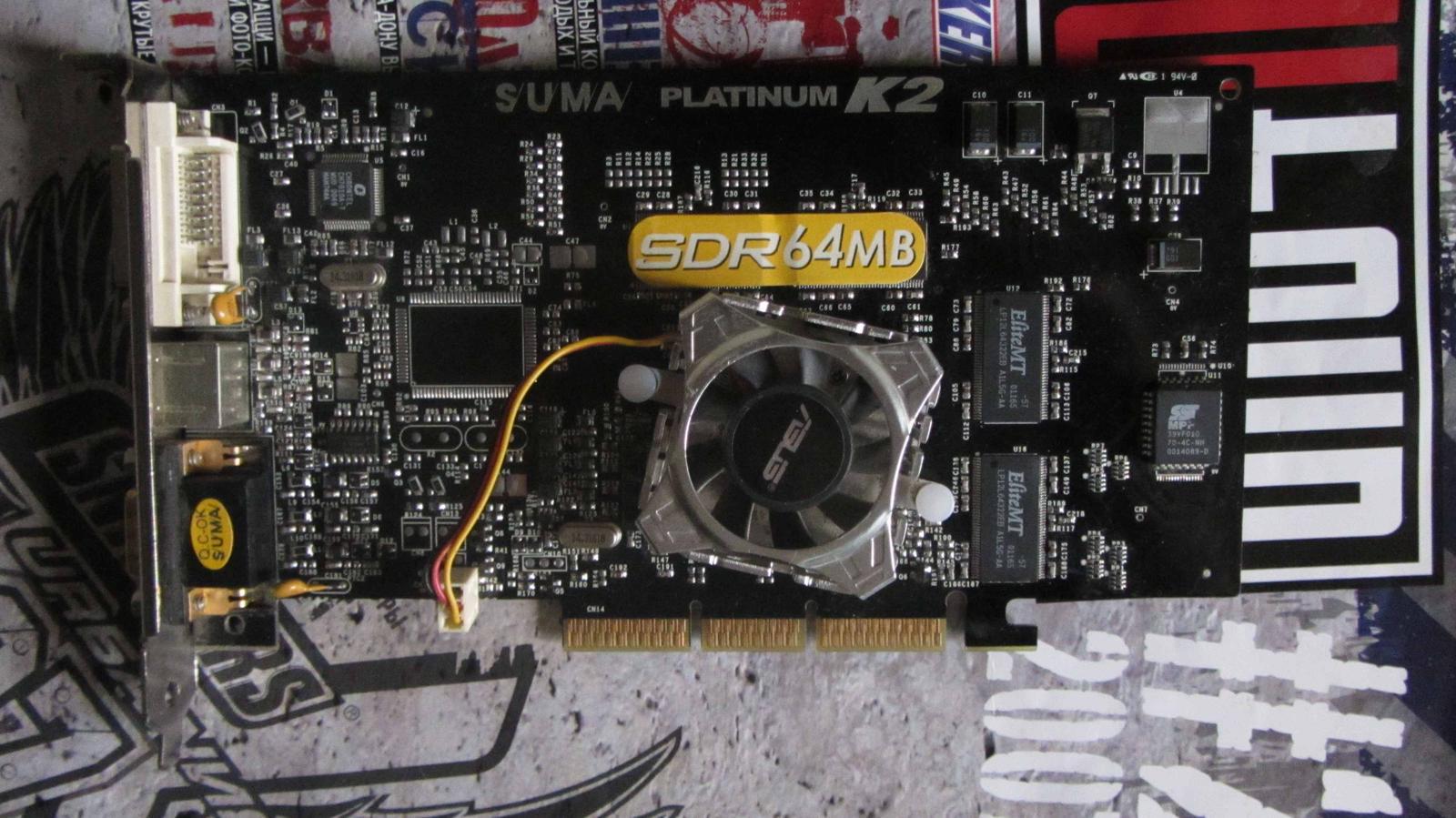
It seems as if the card has not far gone (if at all) from 5500 voodoo: all the same 350Mtexels, 64 meters SDR memory, 2 pixel pipelines, DX6 (and, as a result, the complete absence of shaders), all the same AGP2x with sideband (and without buns) ... but it only seems .
Closer to heart
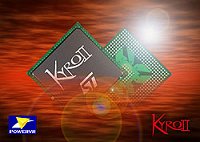
The PowerVR Series 3 chip itself is born in 2000 . This was already the third (let’s omit the revision) phenomenon to the people, which for the first time crowned with something. Apparently, the chip was so successful that it was able to once again inherit in history already in 2004: a certain company Pixel Perfect made a card on it (and again according to the reference design and again with a cooler, which is already gone and, yes, this also had to be repaired). So her autopsy showed that the chip is not at all PowerVR Series 3 . So, sit down, here you need to tell about the now truly legendary Bermuda triangle: Imagination Technologies - PowerVR - STMicroelectronics
. This triangle was definitely there, but none of ours met it, and now it definitely isn’t. Legend has it that in those years, PowerVR was not a division of Imagination Technologies at all, but simply a brand (which they owned) for a bunch of technologies. Well, the notorious STMicroelectronics bought a license from Imagination Technologies and riveted chips with these innovations at their capacities. Because Imagination Technologies did not have its own capacities. It is difficult to even say which of the two actually came up with the name KYRO (but it can be argued that this is a derivative of Cairo (Cairo)). Well, specifically this STG4500-X chip (in the common people of KYRO II ) is the PowerVR Series 3 .
Well, that is, as you correctly understood, there was at least one more incarnationPowerVR Series 3 - STG4000-X (or KYRO I ), which was essentially identical to KYRO II, only worked at a lower frequency ...
... But the insides of KYRO II are already on the table and get frozen:
- The chip has only two pixel pipelines, but they always work, so it doesn’t matter if multitexturing is enabled in the game or not. Thus, the Mpixels here are equal to the Mtexels ( yes, like in voodoo ;)).
- But much more interesting is how these pipelines work. And here we come to where we started - to interesting, to tile architecture . I have not seen an
exact explanation of how Tile Based Deferred Rendering (hereinafter referred to as TBDR ) actually works . There are several different options from which you can get such a general idea:
... A decrease in FPS is most often the result of a video bus overflow. But how can we avoid overflow? The main idea of TBDR is to get rid of the unnecessary work of an already hackneyed 3D pipeline, which will seriously reduce the requirements for video memory bandwidth. How? Why is it stupid to draw each polygon in turn (as IMR cards do), KYRO, following the concept of TBDR, first compiles a list of all polygons in the frame (display lists). KYRO then checks which polygon closes and finally shades, textures and paints only the really visible parts of the polygons. Logical and simple.For lovers of diving ...Kristof Beets explained TBDR as follows:
Before starting to work with the frame, PowerVR KYRO- based video cards split their framebuffer into small rectangles ( tiles ) , 16x32px or 32x16px or even 32x32px, etc. depending on the version of the chip. The PowerVR KYRO chip architecture also has a special tile-buffer for working with these tiles. Tile-buffer is a matrix, each cell of which corresponds to one tile from the framebuffer. Well, the 3D pipeline looks like this:- Tile Binning (Sorting) .
The application generates a frame with polygons in RAM and gives this frame to the video board. The frame with polygons that the application gives us (hereinafter referred to as the scene buffer ) contains the vertices, the depth value (Z), and other related information about each polygon. Each KYRO landfill is assigned a unique number.
First, each of the polygons in the scene buffer only tries onto the framebuffer tile grid. As a rule, he gets on one or several tiles at the same time. In each tile-buffer cell corresponding to the tiles that our polygon hit, the number of this polygon is written. Thus, we get a filled tile-buffer matrix with links to polygons from the scene buffer. This allows us to understand which polygon in which tiles is present.
- The Hidden Surface Removal Algorithm
This is where the fun begins. Simply put , each polygon has a depth value that indicates how deep the polygon is in the scene (Z value). If several polygons fall into the same place, only the one with a lower depth value will be visible (we do not take transparency now). Well, that is, for each pixel in the tile, the chip finds out which polygon of all that hit this pixel will actually be visible.
For example, the tile-buffer cell looks for tile # 43. As you remember, this cell contains the numbers of polygons that fell into tile No. 43. Each of these polygons takes turns from the scene buffer. The value of Z and the number of the first polygon is remembered (where exactly, it is not specified) for each pixel of the tile to which it fell. The second polygon from the tile-buffer is taken, it is also run by tile, and if somewhere in the pixels of the tile an overlap is detected, the one that is closer to us (resolved by the Z value) is remembered. As a result, it turns out who on what pixels of the tile is on top.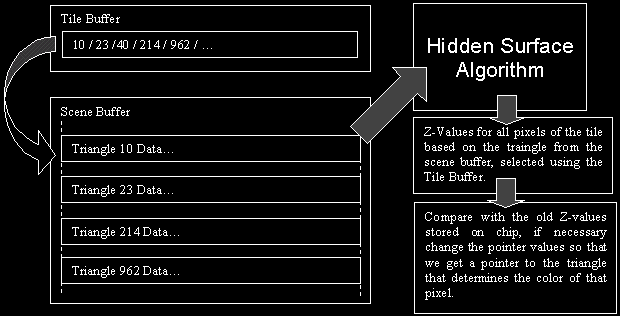
Transparency is a bit more complicated, but the principle is the same. It will be possible to make and remember (somewhere_in_the_new_buffer) a list of transparent polygons for each tile and then use it. Or you can, for example, reorder the tile buffer as needed. You can also read how PowerVR actually sorted transparent pixels . - Actually Rendering
Well, now we fill every pixel with paints. The scheme is called Display List Rendering:
At this stage, the KYRO chip colors all the pixels for each tile, and in one pass, it manages to make one line of pixels, according to the PowerVR presentation .
As a result of such simple manipulations, we get 1 full-fledgedtrolleybusframe (which would be nice to make 60 pieces per second)
- Tile Binning (Sorting) .
- In addition, PowerVR announce the ability to immediately apply up to 8 textures per pixel , explaining that all the same, everything invisible is eliminated. For 2001, of course, it was nonsense, since there was not a single game, it’s a matter of skill, but in the tests you could finally see an honest EMBM . Indeed, what difference does it make, how many textures are superimposed if only the last layer is visible? Sly, of course, but, perhaps, thanks to TBDR, the chip will have time to calculate everything in a reasonable amount of time?
- In the case of anisotropic filtering and OGSS super-sampling anti-aliasing 4x , which the chip can also do, PowerVR puts forward the same argument. It sounds beautiful, of course, but you can't get the calculations anywhere. If everything was so cool, you could immediately do 16xAF for the same money, no?
- How, you and this is not enough? In this case, delve into the insides a little more and you will find with interest that KYRO II actually supports AGP4x and, with a great desire, you can act like those fanatical personalities who need to have checkers to go. By the way, there is a legend that they did exactly the same with voodoo5.
But here you are looking, looking and ... do not find. That's right, alas and ah, Hardware Transform and Lighting (hereinafter - HW T&L ) is not here either. And here's why (clipping the FAQ from the powervr.com online archive ):
KYRO and T&L
“No hardware T&L? You must be joking! ”
Indeed KYRO and KYRO II hardware do not support hardware T&L. While this choice might surprise there are good reasons behind this decision.
The truth is that most games available at the moment are fill-rate limited. As frame rate and resolution increase the graphic hardware reaches a point where it cannot transfer data as fast as the CPU would like to. This is the famous memory bandwidth problem. While the graphic hardware struggles, the CPU is idle waiting for the next frame to finish rendering. Why waste this precious CPU time when it could be used to handle transformations? As an example, consider a game at 1280x1024x32 resolution running at 60 frames per second. We'll assume a depth complexity of 3 for this game, although this figure could easily be higher as games get more complicated. The fill-rate requirement for this game is 1280x1024x4x60x3 = 943 Mpixels / sec. This figure is at least twice the real fill-rate of other hardware, which means the game is fill-rated limited.
KYRO II was designed to be a mainstream part and including a T&L unit would not only cost more but also it would not improve performance in most cases (depending on CPUs and games). There will be a time when hardware T&L will significantly improve performance but it is still not now. If a game is already fill-rate limited, adding hardware T&L to it will not make it run faster!
Well, that is, if Nvidia decided to accelerate the geometric part of the 3D pipeline, then PowerVR accelerated the rest .
Implementation
I dare to please you: KYRO is trained in Windows XP! (2001, after all, was time for Longhorn to be already). So I fled from the Millennium Tube in fear! For this I got the full possibility of OSD monitoring in games through the fresh MSI Afterburner , as well as the human interface and OS stability. True, you can’t get out of the blue screen anymore, this, of course, is a minus ...
Nevertheless, there were no firewood built into Windows for KYRO. But PowerVR itself had two: last and last beta ( just like 3dfx, yes ... ). This is how the latter look:
- On the main tab there is overclocking :)
- OpenGL with PretzelsWho did not understand, F1
- Direct3D with bunsF1
By the abundance of buns and pretzels, it becomes obvious that TBDR does not have everything smoothly with games. But the firewood developers have already taken care of the most popular ones. Yes, that's right, in the drivers you will definitely find a file warning Windows that the porsche.exe application will need a bun (and pretzel!), But not that:
In the last beta beta there were more than 100 such applications (and games) ...
... But, unfortunately, in the marvelous Arabian Nights to the right of the saber, there seems to be a menu:

There are no KYRO plushies to appease; and there were probably a lot of such games? And all for why: at the dawn of the rise of DirectX as a de facto standard, many developers implemented the craziest 3D rendering techniques on their own. So what, did it work? Yes, on IMR cards, the 3D pipeline of which has not undergone changes since its birth until 2000. But KYRO with its TBDR is still better to use in games of at least the DirectX6 era.
In addition, skis do not go ... Considering that both of my cards are after repair, one with stitched BIOS, and the second with custom BIOS of 2004, most likely the second. Nevertheless, the same problems on both cards: you set one resolution, you get another (and which one depends on the version of the firewood). So,I couldn’t set 1280x1024 in 3D under any conditions on any of the cards.
Application level
ATTENTION, Config:
MB: Gigabyte 6vtxe (Apollo Pro133T chipset)
CPU: Pentium 3-S 1.4Ghz / 512Kb / 133FSB
RAM: 3x256Mb PC133
HDD: healthy UDMA-5 WD with a decent 2MB cache and 5400RPM
WinXP SP3
Video: PowerVR KYRO Video: IIVP KRO
IMPORTANT:
- We will look at Deus Ex , for the sake of justice (well, so that it can be compared with previous reviewers). However, be aware that due to the architecture of the chip (TBDR), the results, for example, in Quake 3 will be completely different in terms of performance. This is largely due to the peculiarity of games and their engines: somewhere huge overdraw (2-3) and x4 multitexturing, and somewhere just a huge bunch of polygons, but almost no overdraw.
- Graphics settings in the game: maximum colors , all sorts of trilinear and volumetric lightning there!
- Firewood settings ... well, let's experiment!
- There is no point in overclocking a card ; these cards practically do not overclock (again, due to its architecture).
So, let's go
API
- Direct3D. Как следует из спецификации, карта поддерживает DirectX7. На самом же деле, карта поддерживает только DirectX6, но, чтобы как-то оправдаться, разработчики дров запилили эмуляцию HW T&L (как в 3dfx, да...). И вот эта самая эмуляция появится только в последних-бета драйверах.
Работает она точно также, как и у вуду5, поэтому подробно останавливаться на этом моменте я, пожалуй, не стану. Иногда помогает: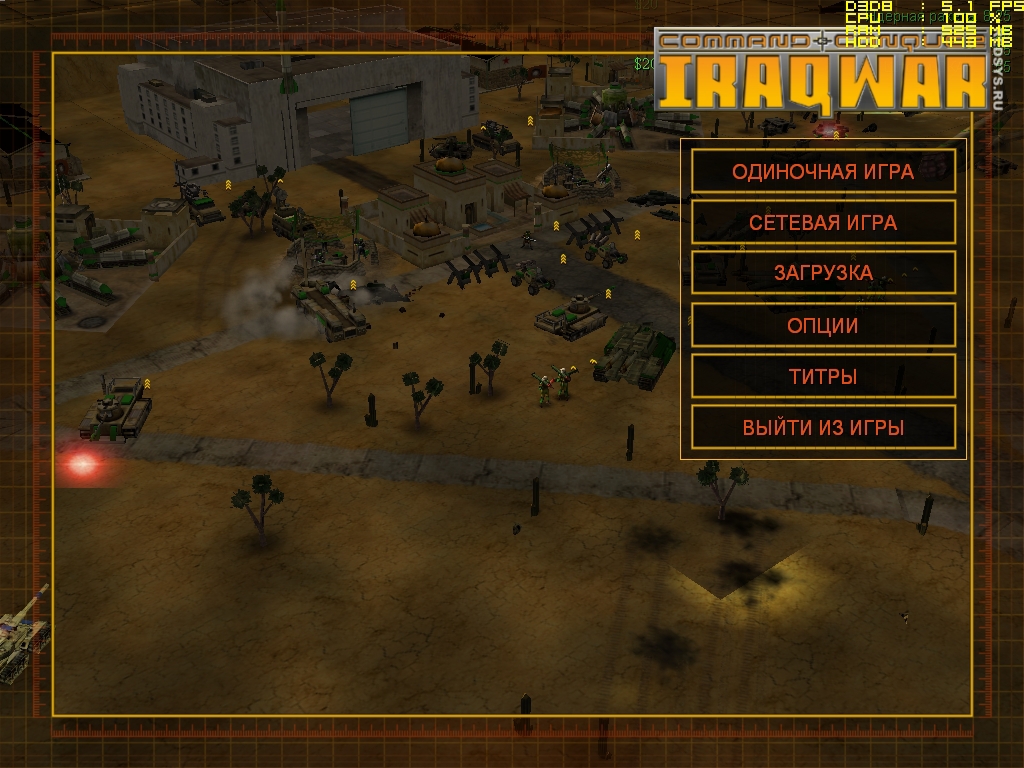
- OpenGL. Тут всё предельно просто и надёжно: ICD. По сравнению с версиями для предыдущих чипов это — гигантский прорыв! Правда, вы можете случайно увидеть такое:
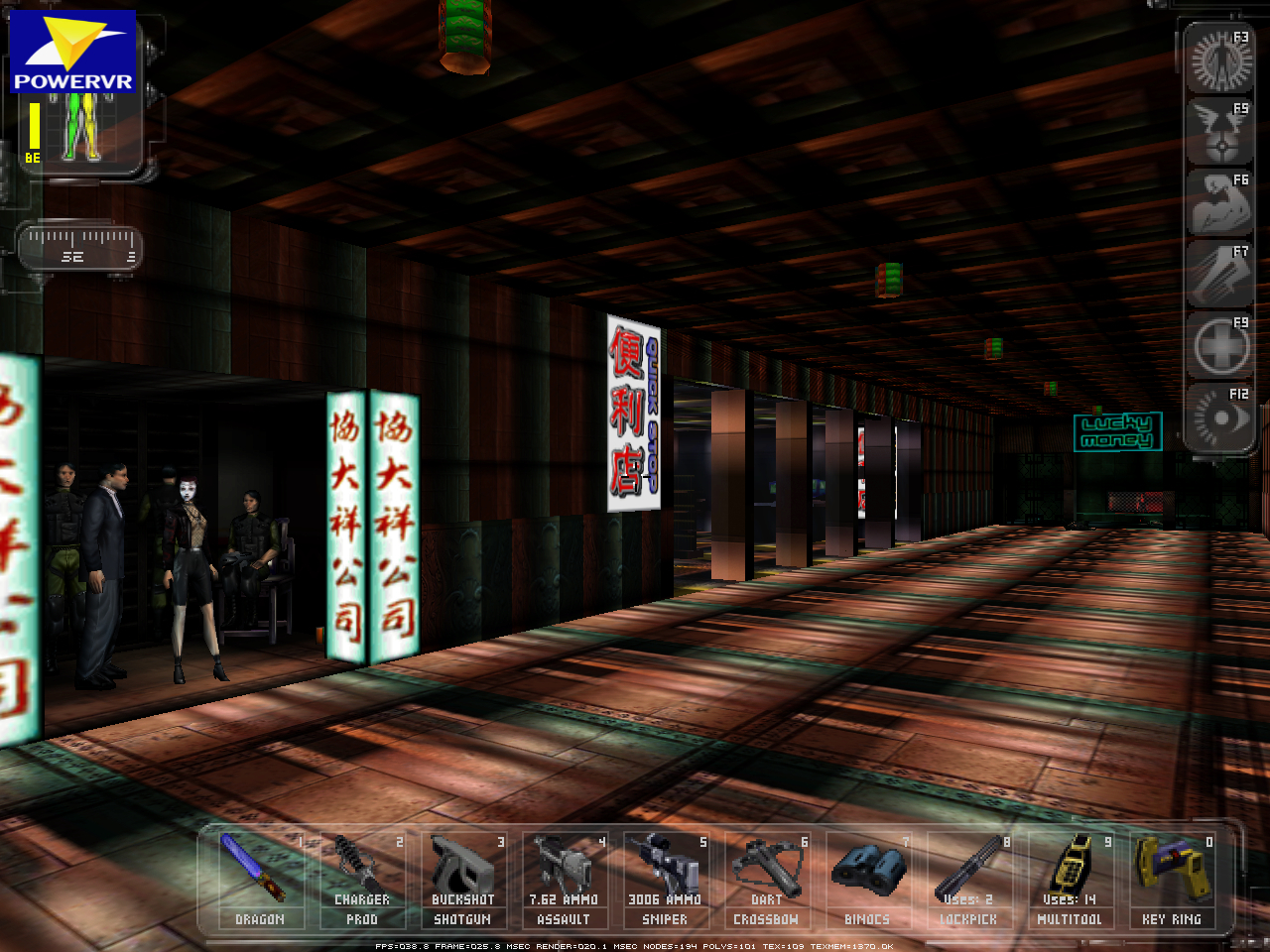
Но в последних-бета дровах это поправили. - PowerSGL Direct. Если кто помнит такой,- был актуален для ранних чипов PowerVR, потому что:
…
Infinite planes effects were not part of Open APIs and full capabilities of PowerVR can be exploited only through proprietary SGL. The API also supported data instancing to save memory by avoiding duplicates of materials, transformations and objects.
…
vintage3d.org/pcx1.php
С выходом KYRO явно потерял актуальность, вероятнее всего потому, что пресловутые Infinite planes не прижились, а реализация data instancing к этому времени появилась в OGL и/или в D3D.
И всё же в дровах присутствует файл SGL2.dll (и с каждой версий допиливается!). Судя по тегам в файле, это PowerSGL Direct2 (кто думает, что осилит в чём разница: SDK для первого). Но, поскольку все известные мне игры под PowerSGL исконно ищут файл SGL.dll, логично было быналить и отойтипереименовать и посмотреть, что будет. На примере Unreal (версия с поддержкой SGL):
Я даже честно пытался подсунуть играм SGL.dll(and accompanying file) from firewood for PowerVR Series 2 - about the same result. It turns out that PowerSGL Direct was thrown out, but why then finish the PowerSGL Direct 2 ? Anyway, if you want to play beautiful Tomb Raider - buy PCX2 ...
Colorfulness
In addition to full support for 32-bit color and even the ability to work in 24-bit ...

... KYRO has one cool architectural feature: the entire 3D pipeline works all the time in 32-bit color. IS ALWAYS. This means two things:
- When switching to 16-bit color, it will not become faster.
- The quality of the picture in 16-bit color is even higher than that of the praised 3dfx with their 22-bit. And all because, according to the canons of TBDR, the conversion of a frame from 32-bit to 16-bit is done only once - at the output. Whereas IMR in 16-bit mode, with each new overlap, for example, texture to texture, the texture is converted from 32 bits to 16 bits.
Nevertheless, I propose

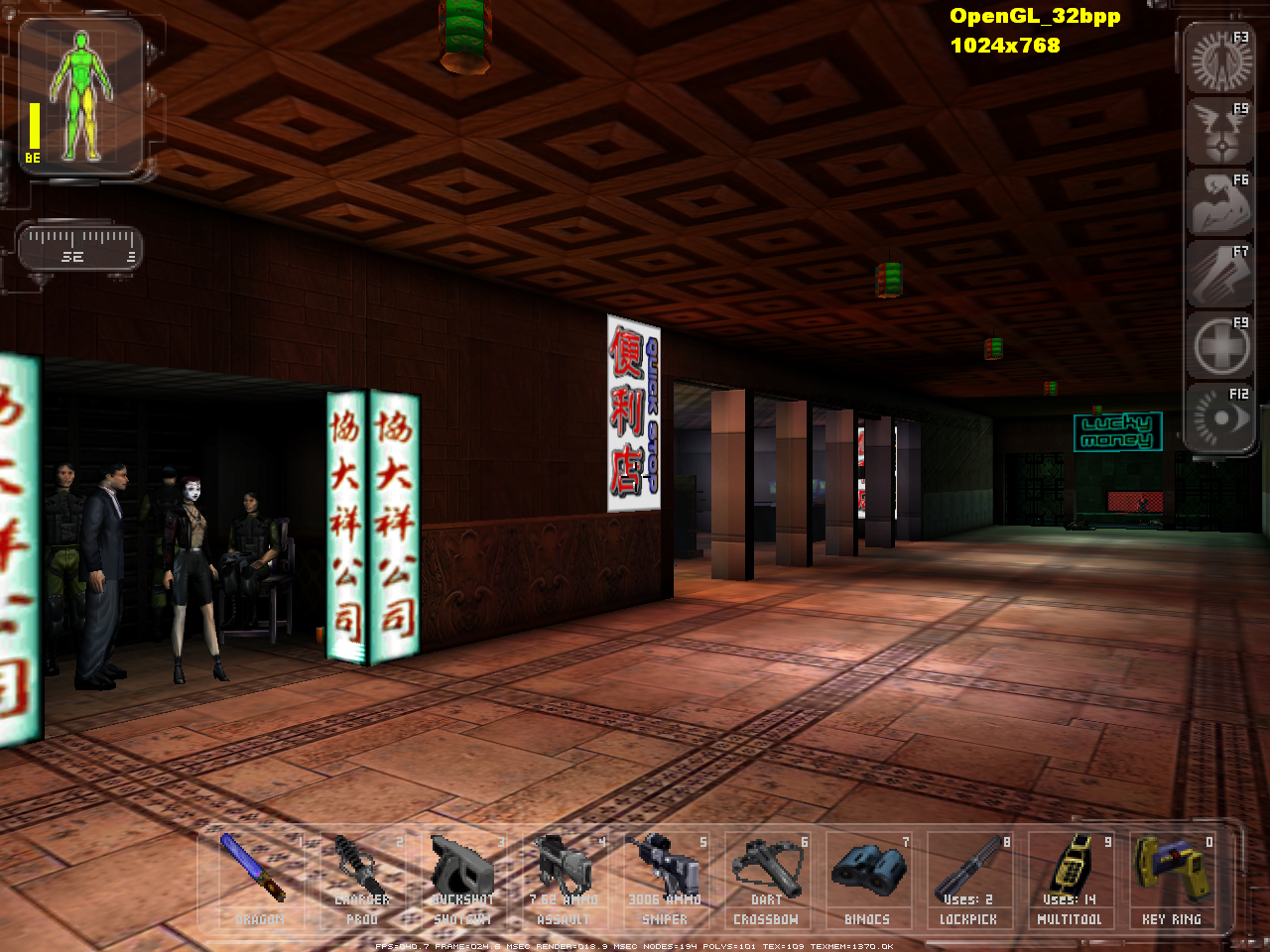
The most interesting. Performance
After all this lecture, a simple person raises a simple question: “could it really be faster than the Giraffes with the Radeons?” In fact, if you did not go into details, everything depended on the case :) I will quote myself:
Due to the architecture of the chip (TBDR), the results, for example, in Quake 3 will be completely different in terms of performance. This is largely due to the peculiarity of games and their engines: somewhere huge overdraw (2-3) and multitexturingx4, and somewhere just a huge bunch of polygons, but almost no overdraw.
Full-Scene Anti-aliasing (FSAA)
Cleans ladders on sloping lines. In this chip, three types of FSAA are implemented using the OGSS method:
But here, everything is not easy. As I responsibly stated above, setting up 1280x1024px on KYRO II is not possible (in fact, much more is obtained). At first I decided that, in this case, you can be content with a resolution of 1280x960, since 64 pixels in height is not the biggest loss.
However, a surprise awaited me here . It turns out that in high horizontal resolutions (when the horizontal is greater than 1024px), the FSAA option 2x1 and 2x2 (this is when the picture is doubled horizontally) will not work. Because the chip does not know how to work with horizontal resolutions greater than 2048px.
So for starters, let's see how the FSAA works in the resolution of 1024x768 . In the picture, look at the aliasing (ladder) at the vertical legs of the chairs on the table and at the aliasing of the horizontal lines at the lamps (or at the table): Perhaps some particularly attentive persons have noticed that the Horizontal FSAA removes the stairs vertically , not horizontally. And vice versa. As I was told below (thank you, MrShoor ): horizontal FSAA increases the horizontal resolution of the image, and, therefore, removes the vertical ladders. What can be noted is that (what?) Contrary to many rumors of the FSAA, nifiga is not free and FPS decreases markedly with increasing degree. That is, everything is as always here: Do you want? Pay! This is the first.
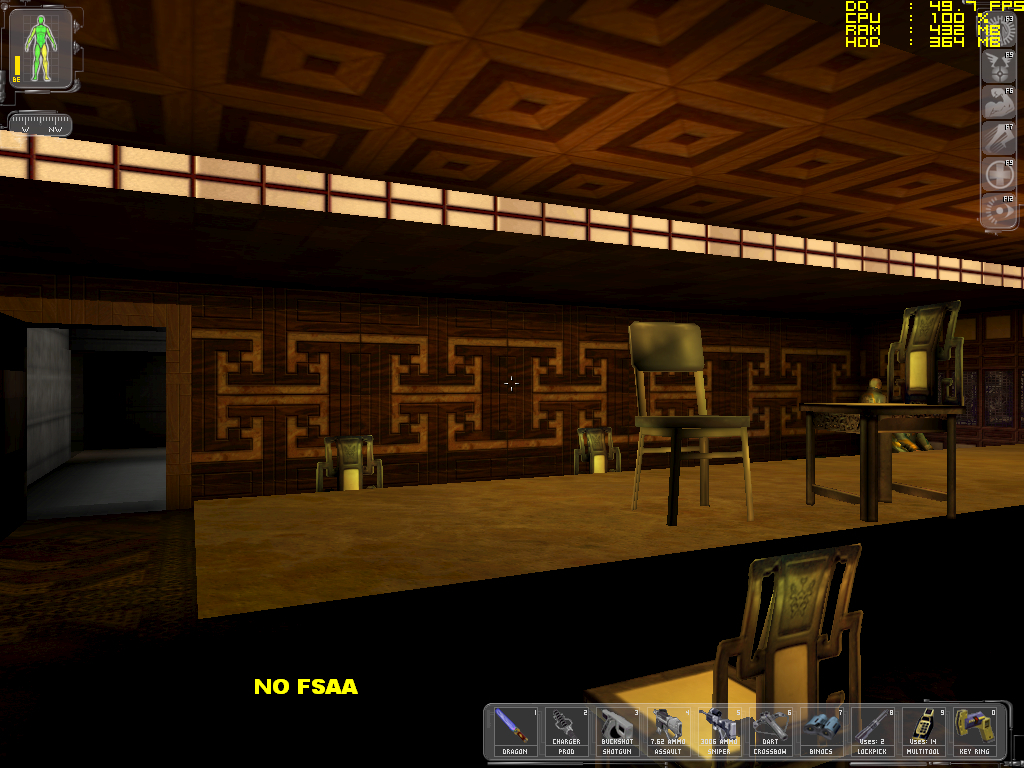

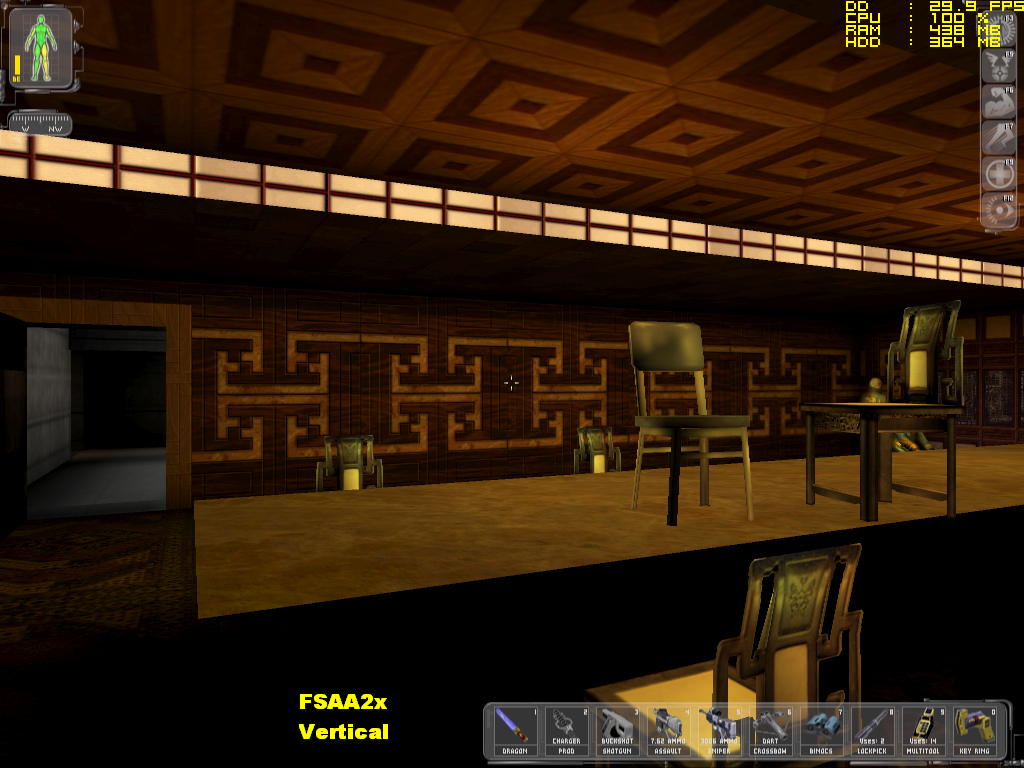
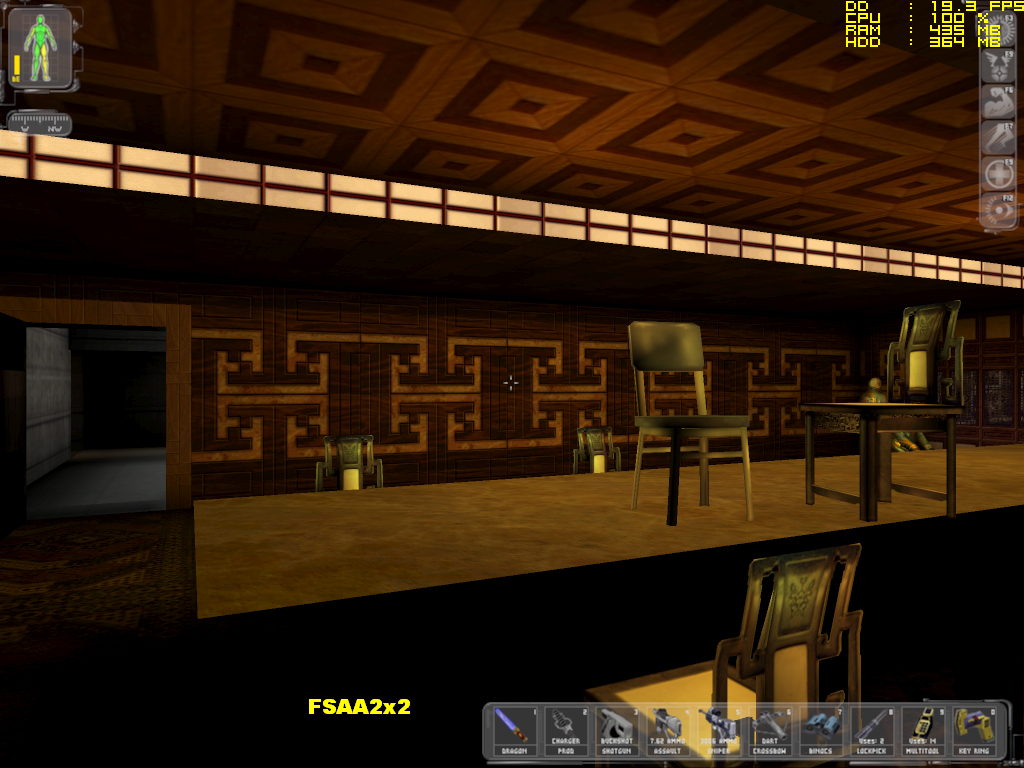
And secondly, in fact, the quality of this very FSAA, I tell you ... like through dirty glass. It's still nothing on the shots, and you pull it on the whole screen, you will immediately understand (today every browser has a carriage). In addition, as you understand, you can smooth either one side or both; 2 samples on both sides (like 3dfx) cannot be ironed. No, nevertheless they say the truth, OGSS is far from RGSS, which was used in voodoo5.
Anisotropic Filtering (AF)
This is the development of the trilinear. You don’t select a degree, it just exists :) To understand what it’s doing, look at the repeating pattern on the left wall and how it is clearly visible with increasing distance from
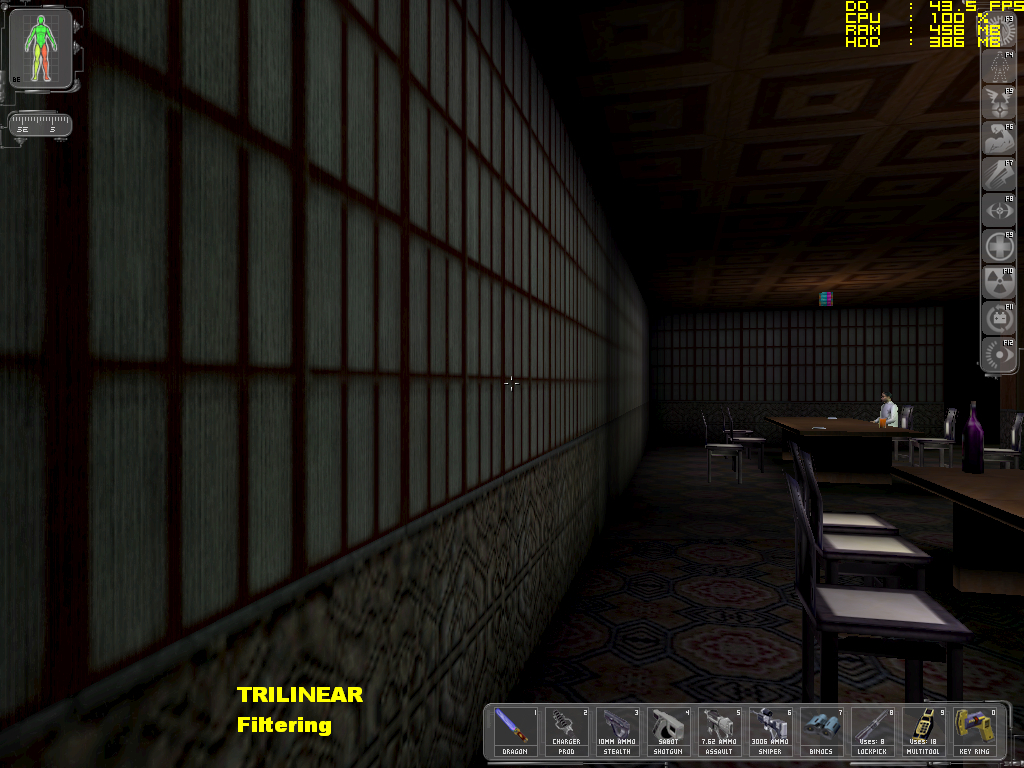
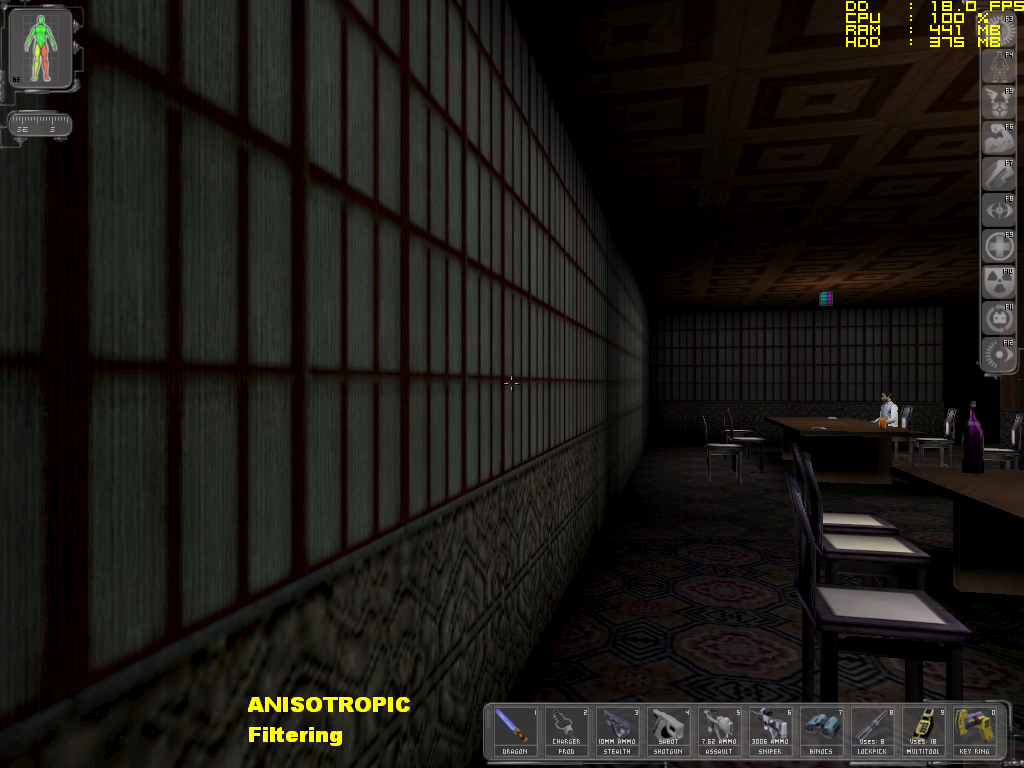
FSAA + AF
Well, of course, you and I need to understand how the card will keep up with all this. And here:
1024x768 . Here you can still do a full FSAA, so to speak. Let's try it. 1280x960 . Here we can already do FSAA only vertically. In total, KYRO II does not tolerate AF + FSAA - nobody is interested in watching a slideshow. Well, since the quality of the FSAA can be rated "bad", it is proposed to celebrate the joy of increasing resolution and forget about it forever. In high resolution, you can turn on AF, but it will be slow. So, ladies and gentlemen, in Deus Ex (and similar games), KYRO II seemed to so unobtrusively offer you to be content with the trilinear and wait for the next chip with the HW T&L block to be released. But no one waited for him. So TBDR ended on PC.
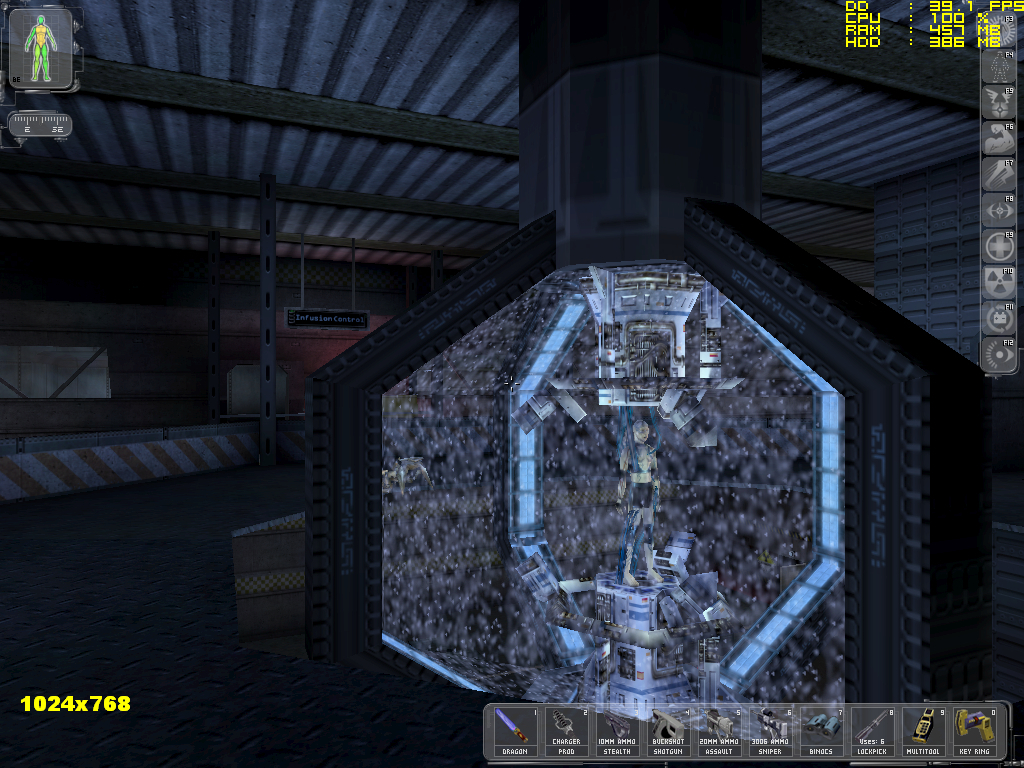
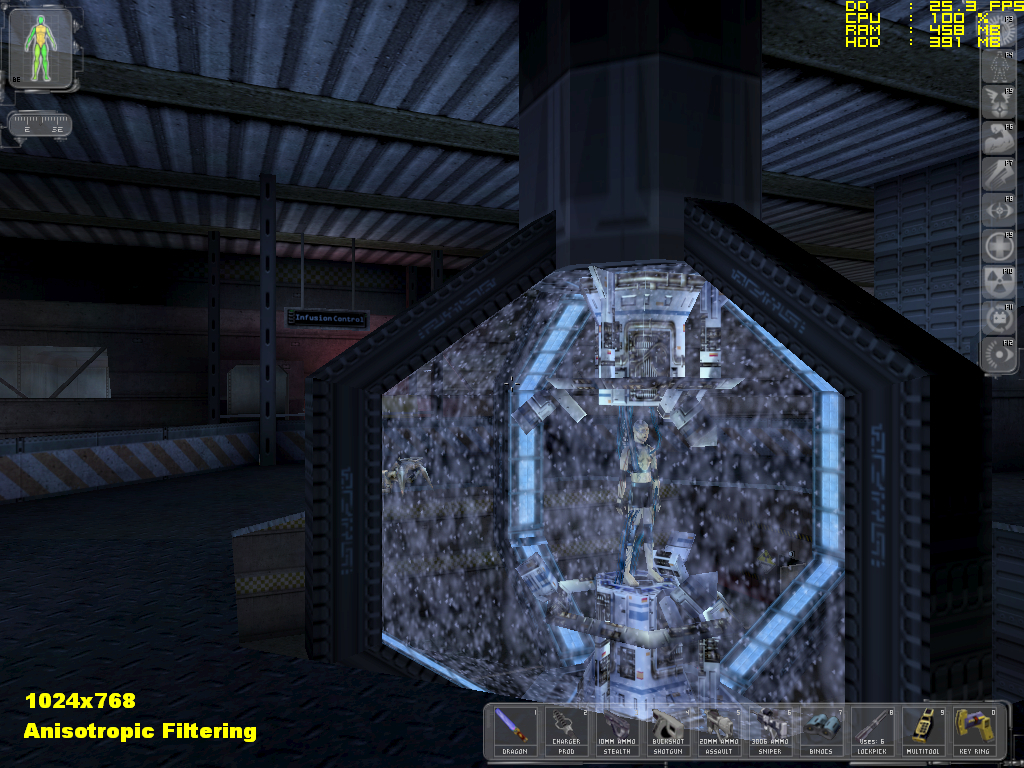
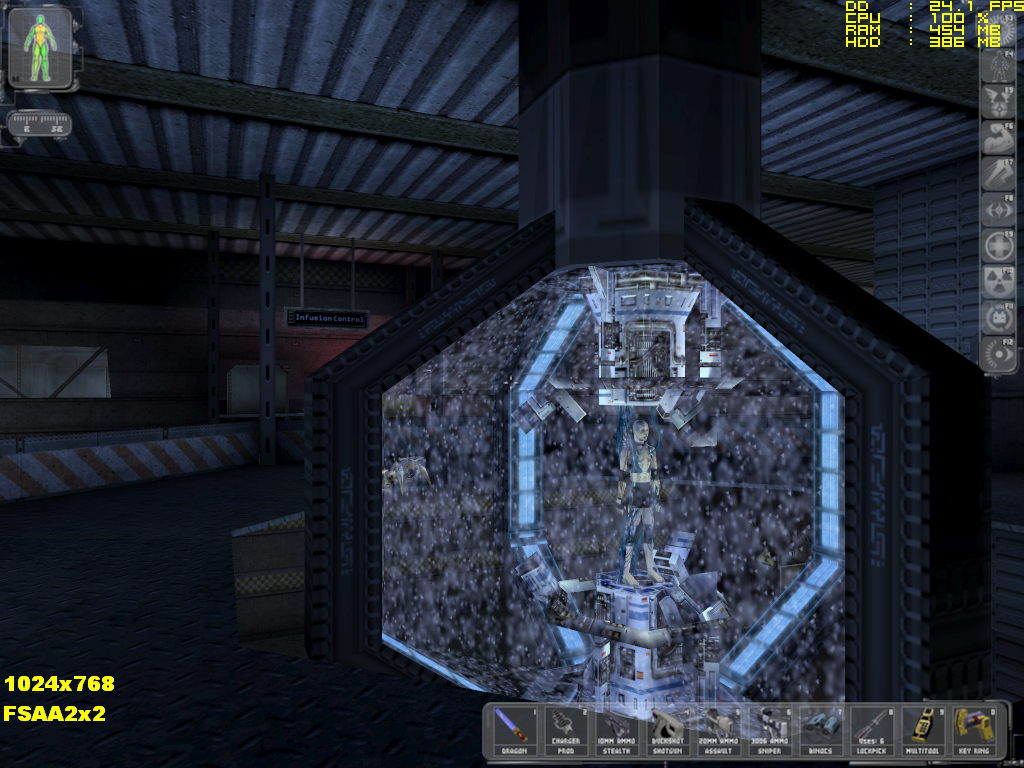


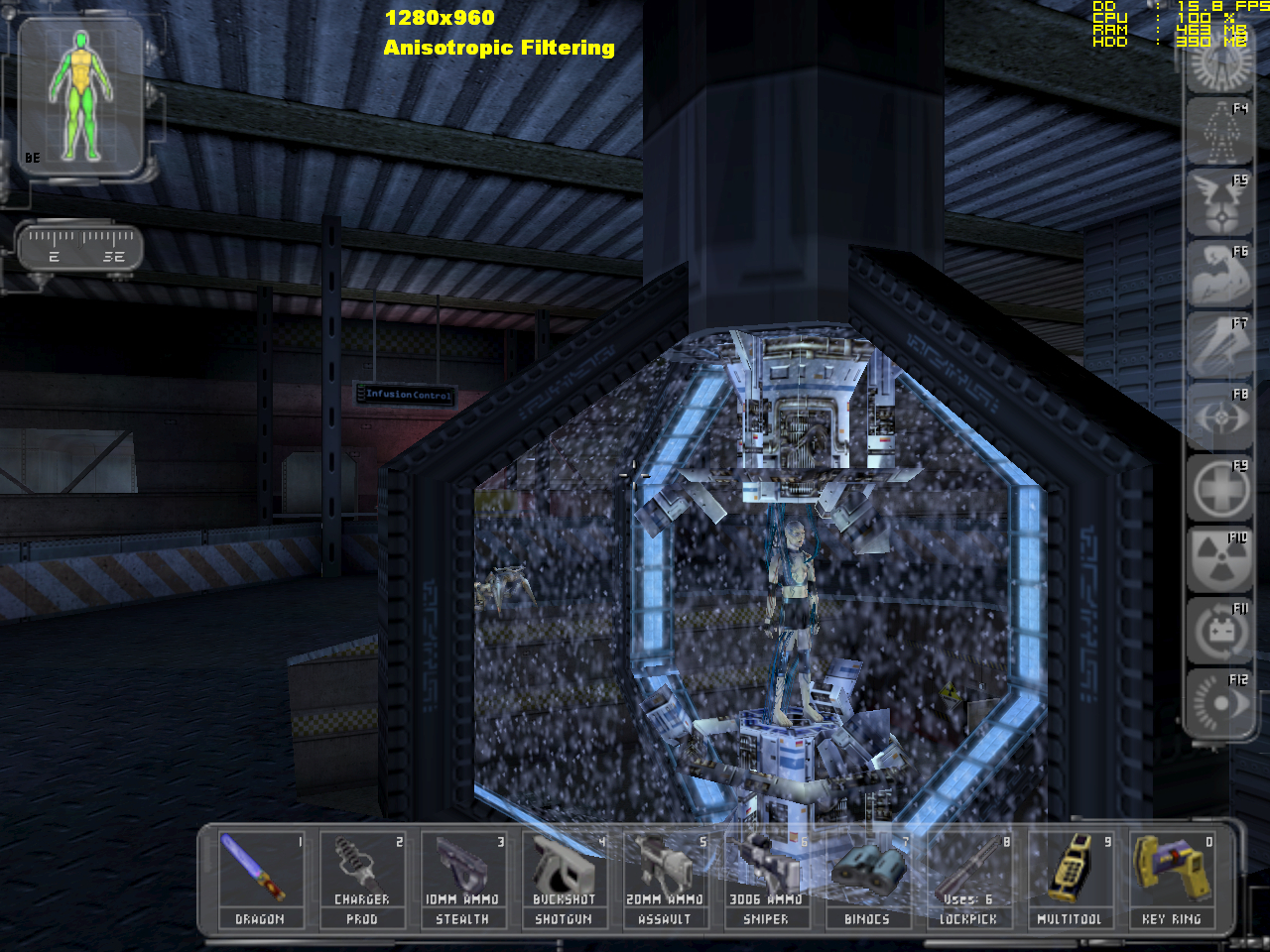

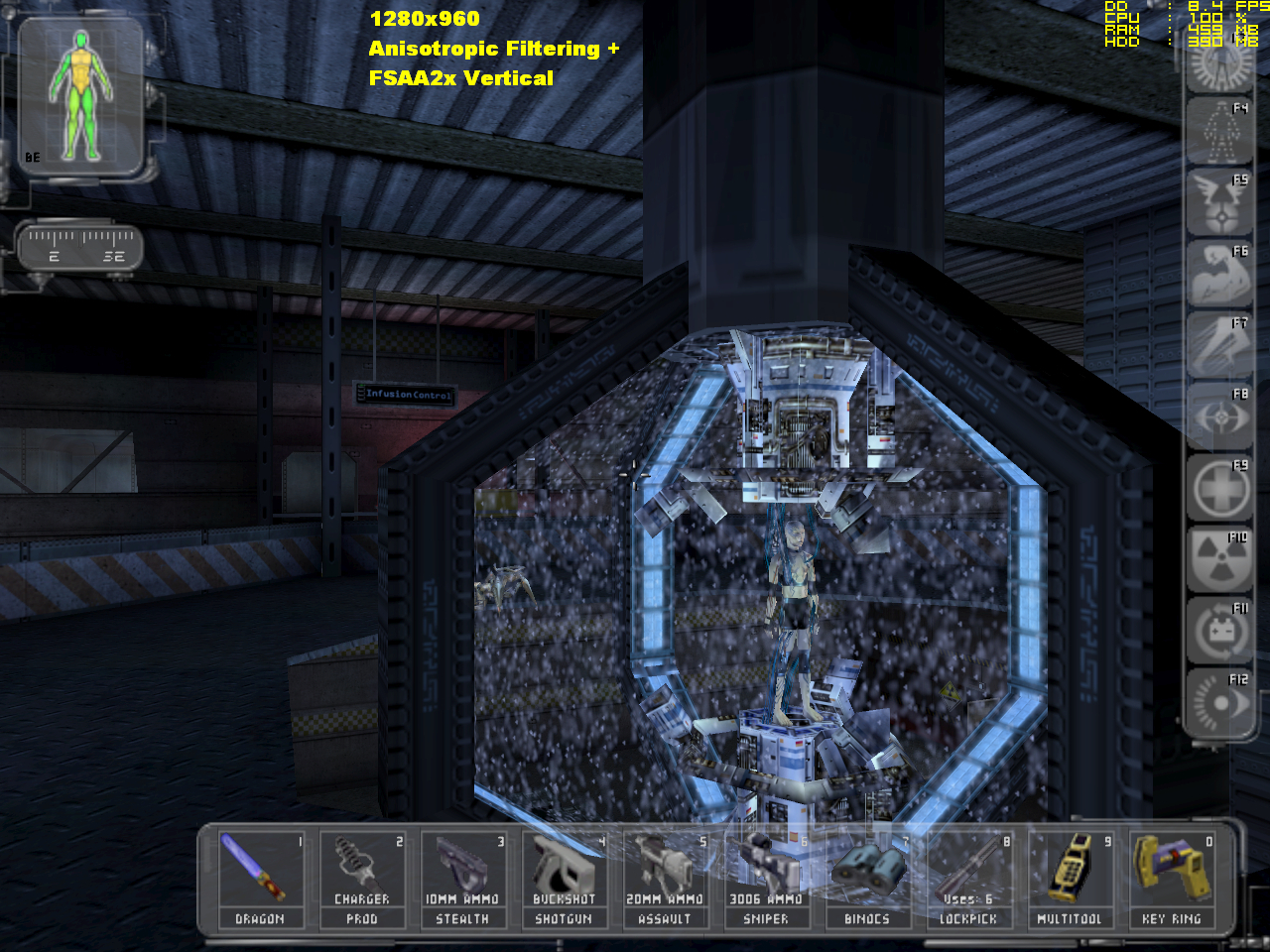
Well, you know ...
If we discard the architecture of KYRO itself - for the average student it was the most ordinary video card, which did not have any obscure approximations there, 22-bit color, forbidden api and other crap, for which today there is an occasion to assemble an old computer. In KYRO everything was:
- Extremely simple : honest 32-bit color, full DX6 support, DX7 emulation.
- Extremely fast : there was nothing to disperse
- And extremely cheap :)
For the money that was then requested for cards on the KYRO II, it was a sweetie. Yes, with a sweet and sour filling, but still it was better than the huge assortment now presented by two well-known companies.
It will not be out of place to note that the fate of PowerVR in the PC segment is in many respects similar to the fate of 3dfx ( you can even recall the dying purchase of Gigapixel ). The same stunning innovations, the same problems and, as a result, the same exit delays. As a result, leaving the market and the death of another closed api (PowerSGL).
In general, in the end, it all comes down to the fact that two things can be said for sure:
Everything new - poorly buried old.
Казалось бы, что касается ранних подходов в вопросе оптимизаций видеочипов путём разработки собственного закрытого низкоуровневого api и заточке игр под эти api (если не поняли, перечитайте ещё разок) — сегодня это всё уже пыльная история (которую, кстати, поди раскопай!). А вот нифига! Вы посмотрите, какой там уже внушительный список игр!Будущее не предопределено!
Во многом благодаря PowerVR в обозримом будущем мы смогли наблюдать интереснейшие вещи. Так, уже в 2007 году в свет вышел любимый Сталкер: Тень Чернобыля, движок которого использует технику под названием Deferred Shading. Нетрудно догадаться, что в основе лежат те же принципы экономии пропускной способности видеопамяти, что и у PowerVR. Но только программным путём с помощью шейдеров для IMR.
Благодарности
- Кланяюсь двум инженерам из одной Питерской конторы, которые помогли деталями и даже их припаяли за меня! Без них обзоров вуду5 и кайро просто не было бы!
- Администрации old-games.ru за возможность быстро и бесплатно скачать 20 игр скопом только ради того, чтобы заценить структуру файлов и однажды запустить.
- Открывателям горизонтов и срывателям покровов — комьюнити VOGONS. За кучу уникальных исследований и наработок!
...TBC...
Использованная литература
Briefly about PowerVR on VOGONS
Detailed review of KYRO
Detailed review of KYRO II
Outdated and fresh theory of tile rendering PowerVR (moreover, not one of them contains the whole truth!)
Proof of statements from PowerVR (from archive).
A detailed tutorial on 3D graphic pipeline .
Kristof Beets's blog on the architecture of modern PowerVR chips.
vintage3d.org is a very good site with very early 3D reviews
Detailed review of KYRO
Detailed review of KYRO II
Outdated and fresh theory of tile rendering PowerVR (moreover, not one of them contains the whole truth!)
Proof of statements from PowerVR (from archive).
A detailed tutorial on 3D graphic pipeline .
Kristof Beets's blog on the architecture of modern PowerVR chips.
vintage3d.org is a very good site with very early 3D reviews
